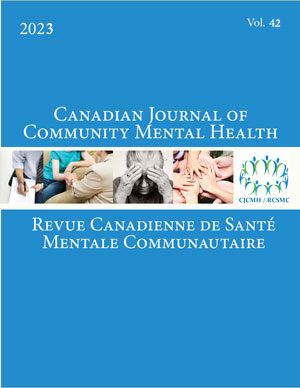Volume 20 • Number 2 • September 2001
OPEN ACCESS
OPEN ACCESS
OPEN ACCESS
This paper makes a case for using the institution as an extension of community resources rather than as a place for the exclusion of young offenders. This argument is built on 2 case studies that highlight the importance of treating young offenders in their own community and the need for permeable boundaries between institutions for young offenders and their communities. It is shown that processing youths as young offenders without helping them to maintain a sense of belonging to the community threatens their identity. Collaboration between institutions and communities to address the root causes of problems presented by at-risk youths and their families is as important for serious offenders as for their less delinquent peers. While the Youth Criminal Justice Act does not preclude movement in this direction, it is ambiguous about the development of community alternatives for serious offenders.
OPEN ACCESS
Seventy at-risk adolescent girls in 7 residential facilities were interviewed over a 12-month period. The girls were asked questions regarding experiences, thoughts, and feelings about physical and verbal fights with friends and parents. Results showed that many of these girls reported different reasons for starting and escalating verbal and physical fights, they had more negative feel-ings for verbal fights than for physical fights, and had similar thought pro-cesses during both kinds of fights. More girls acknowledged responsibility for starting fights with parents than they did with peers. Implications of the results for treatment of female young offenders and the development of public policy are discussed.
OPEN ACCESS
Conduct disorder (severe and persistent antisocial behaviour in children and youth) is an important community mental health problem in Canada and has been the focus of considerable recent public policy debate. Good research evidence is available on effective (and ineffective) interventions for conduct disorder. Paradoxically, however, relatively little of the research evidence is incorporated into policy decision-making. There is a policy-research gap. An example (Hamilton, Ontario) is used to illustrate this gap. The gap is then explained using a framework for health policy analysis that incorporates values, institutional structures, and information. Values and institutional structures greatly outweigh research evidence in influencing current Canadian policy-making for the problem of conduct disorder. Possibilities for improving the situation are suggested. The youth who sprang his girlfriend from Arrell Youth (secure custody) Centre has a record many career criminals would envy. Unfortunately for society, he just turned 15 and has discovered an interest in illegal handguns. “This is a one-kid crime wave,” said a Hamilton-Wentworth police officer who spoke on condition of anonymity. “He's not like other child criminals—not even close. He's a bad kid.” That kid is in police custody today (Herron, 1995).
OPEN ACCESS
Les programmes novateurs ne doivent pas leur succès qu'à leur originalité ou leur pertinence. Ils doivent aussi s'élaborer à partir d'un consensus dans la communauté, de l'expertise et de la crédibilité du personnel et d'une approche évaluative. Le programme Virgule répond à ces conditions et s'adresse à la clientèle des jeunes de 10 et 11 ans qui commettent un premier délit. Cette erreur de parcours n'est pas considérée comme un échec définitif dans la vie de l'enfant mais plutôt comme une occasion de changement, d'où la philosophie de Virgule: «Transformer un point en virgule, c'est faire d'une difficulté une raison d'avancer».
OPEN ACCESS
Our purpose is to examine Canada's new Youth Criminal Justice Act in light of Canada's obligations under the UN Convention on the Rights of the Child and in contrast to the Young Offenders Act. After reviewing the Convention and the Young Offenders Act, we examine the new act to determine its consistency with the Convention. We conclude that the new act is a step forward because of its greater focus on rehabilitation and social reintegration. However, it is an inadequate step because it does not fully ensure the protection, provision, and participation rights of the child as defined by the Convention.
OPEN ACCESS
Canada has no standards, procedural guidelines, or protocols for best practices in the care of youths in custody. This paper argues that clear, enforceable standards are important in defining a benchmark of acceptable practice. It argues that without standards, issues may arise which can create further difficulty for youths who are under the care of the state. It suggests that the current legal framework for standards is insufficient in its enforceability and its clarity. The new Youth Criminal Justice Act (YCJA) provides the Canadian government with a timely and much-needed opportunity to establish standards of care for youths in custody. Indeed, the YCJA contains specific, comprehensive, and relevant provisions that can be seen as laying a firm foundation for standards of care.
OPEN ACCESS
This paper chronicles a comprehensive evaluation of 6 residential facilities for young offenders located within the region of Waterloo. Two kinds of research methodologies were employed in the investigation. One was primarily quantitative in nature, involving the completion of standardized scales for each of the youths who participated in the study (N = 129). The other was qualitative in nature, and involved interviews with a small sample of “graduates” from the centres (N = 9), and some of their parents and guardians (N = 4). Residential treatment was associated with significant improvements on the 2 measures developed specifically for the evaluation: a measure which focused on the specific goals which had been assigned to youths while in the program (Catalogue of Goals for Youth in Residence), and the global index of youth functioning which was empirically generated from residential case files (Inventory of Work Life and Social Skills). Qualitative interviews with program graduates and selected parents and guardians generally confirmed the positive evaluation of the impact of residential facilities on youths and served as the foundation for a series of recommendations for programmatic modifications and improvements.










